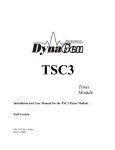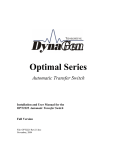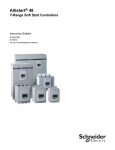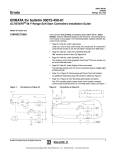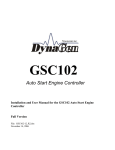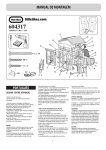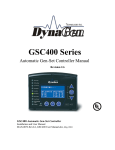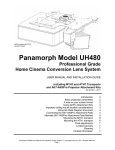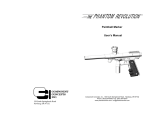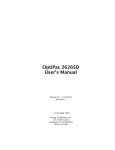Download AST3225-2 User Manual R1.6
Transcript
AST3225 Automatic Transfer Switch Installation and User Manual for the AST3225-2 Automatic Transfer Switch Full Version File: AST3225-2rev1.6.doc May 9, 2003 2 READ MANUAL BEFORE INSTALLING UNIT Receipt of shipment and warranty return information Upon receipt of shipment, carefully remove the unit from the shipping container and thoroughly examine the unit for shipping damage. In case of damage, immediately contact the carrier and request that an inspection report be filed prior to contacting the COMPANY. All returned items must be shipped prepaid and include a return material authorization (RMA) number issued by the COMPANY. RMA forms are available by contacting the COMPANY. Limited Warranty The COMPANY (DynaGen Technologies Inc.) warrants the product with specifications as explained herein. The COMPANY shall repair or replace any defective materials or workmanship, f.o.b. the Company’s factory, which prove to be defective under normal and proper use within three year’s from the date of shipment. This constitutes the only warranty and no other warranty shall be implied. For questions or comments regarding this product, contact: DynaGen Technologies Inc. Phone (902) 562 0133 Fax: (902) 567 0633 Email: [email protected] WEB SITE: www.dynagensystems.com Manual for AST3225 Automatic Transfer Switch 3 Table of Contents 1: GENERAL DESCRIPTION: 1:1 Switchgear 1:1:1 Specification 1:1:2 Operation 1:2 Relay Board Module 1:2:1 Sensing Relay coil Sensing Adjustable Voltage Sensing 1:2:2 System Operation 4 4 4 5 5 5 5 5 2: INSTALLATION INFORMATION: 2:1 General 2:2 Recommended Upstream Protection: 6 6 6 3: REPLACING PARTS 3:1 Parts List 3:2 Main Switch Removal and Replacement 3:3 Motor Removal and Replacement 3:4 Mechanical Limit Switch Adjustment 7 8 9 9 10 4: RECOMMENDED MAINTENANCE 11 5: DRAWINGS 5:1 Limit Switch Replacement 5:2 Mechanical Assembly 5:3 General Arrangement 5:4 Wiring Harness Connections 12 13 14 15 6: FIELD SET-UP: 6:1 Locking Mechanism (Optional) 6:2 Engine Exerciser 16 17 Manual for AST3225 Automatic Transfer Switch 4 1: GENERAL DESCRIPTION 1:1 Switchgear: The AST3225 transfer switch mechanism consists of a basic mechanical switching assembly that can be configured to satisfy various application requirements. (UL listed E200939 Switch Mechanism). This manual describes the AST3225-2 model. (General Arrangement page 14) 1:1:1 Specifications for AST3225-2 model Normal/Emergency/Neutral Lug Connections 300 MCM MA Load connections 320 MCM (Max Wire Size) VOLTAGE NORMAL 208/240 EMERGENCY 208/240 Amperage 225 225 Hz 60 60 Ph Single Single Poles 2 2 Transfer Motor: 120V 60 HZ 2.3 amps thermally protected Withstand/interrupting rating: symmetrical 10 KA. for loading at 100% of nameplate current Enclosure: 24” wide x 30” high x 9” deep. NEMA 4. 1:1:2 Operation: The AST3225 includes the suitable sensing circuitry for automatic transfer of an electrical load to a stand-by power supply in the event of a drop or loss of voltage of any or all phases of the normal power supply. Upon the restoration of the normal supply, the electrical load is automatically re-transferred to the normal power supply. The transfer motor utilizes power from the source to which the electrical load is being transferred. The mechanism provides a positive mechanical interlock to prevent both switches from being closed at the same time. The AST3225 also incorporates the basic actuating motor control switches, terminal blocks, and voltage sensing connection points for Utility Line sensing. Provision is also made for manual transfer of the power sources if necessary. Instructions for the manual procedure are located on the operating arm of the mechanism. The AST3225 mechanism is a lever-operated device controlled by a 120 volt unidirectional gear-motor. The transfer motor drives a crank that in turn operates an aluminum lever arm, by sliding a nylon slider between the top and bottom parts of the arm assembly. The lever, in turn, operates the two switch handles by means of a unique spring and roller arrangement. The travel position of the aluminum lever is detected by two micro switches, which in turn disconnect power to the transfer motor, when appropriate. Manual for AST3225 Automatic Transfer Switch 5 1:2 Relay Board Module: The relay board provides means for automatic transfer of a utility source of power to an emergency source of power, upon loss of the utility, and switches back again, upon restoration of the utility. The relay board has no built in delays for transfer. Any required delays must come from an external source (ie. engine controller, timer module). 1:2:1 Sensing: The relay board module provides 2 types of voltage sensing: i). Relay Coil Sensing: When the slide switch, located on the relay module, adjacent to the 8 pin octal socket, is in the ON or UP position, utility voltage sensing is provided by means of an on board relay coil. The relay coil characteristics set the pick up and drop out of the main utility source. ii). Adjustable Voltage Sensing: When the slide switch is in the OFF, or DOWN position, the on board relay coil is bypassed, and voltage sensing is provide by a UL approved voltage sensing module, which plugs into the 8 pin octal socket. The adjustable voltage monitor is a single setpoint voltage monitor. Input voltages 10% below the set-point range will cause the output contacts to de-energize (unit is adjustable from (190-240 VAC). The adjustable drop out relay recommended for use with the AST3225 Automatic Transfer Switch is the Symcom 201-200-SP-T Rev 5.20. ADJUSTMENT PROCEDURE Rotate the line voltage adjustment to the nominal line voltage feeding the transfer switch. Measure the line to line voltage. If the voltage is up to 10% below the adjustable voltage set point, and the LED on the monitor is illuminated, the adjustable voltage monitor is working properly. The voltage sensor can also be factory set to customer specifications. 1:2:2 System Operation: The relay board module has provisions for 12 and 24 VDC operation. The relay board comes factory set for 12 VDC applications. Changing from 12 to 24 VDC will require cutting the 2 jumper wires located next to the 5-position header. Manual for AST3225 Automatic Transfer Switch 6 2: INSTALLATION INFORMATION 2:1 General The basic AST3225 transfer switch includes all control wiring connections. The electrical switchgear should be installed by a certified electrician, and all wiring to/from the unit should agree with all applicable electrical codes, standards, and practices. An engine controller or timing module (optional) is usually installed at the engine; this installation can be performed by the electrician, or by a mechanic competent at engine wiring. A diagram for wiring up a typical engine controller at the engine is included at Section 5:4, Page 15 Interconnecting the engine controller or timer module controller to the transfer switch is done simply with a 5-wire signal cable. We provide 50’ as a standard length with each order, but any length, in 25’ increments can be provided upon request, for a nominal charge. The “cable assembly” has the transfer switch connector already mounted. Simply install it in the Relay Board receptacle, pass the bare end through an appropriately located hole in the enclosure, and run it to the engine controller or timer module. At the controller, trim the wire to length, strip the color coded wires, and insert them into the appropriate locations of the 5-pin connector supplied for the purpose. Then connect to the adaptor harness. (Also supplied.) 2:2 Recommended Upstream Protection The AST3225 Transfer Switch Mechanism has been approved for use with the following upstream protective device: MANUFACTURER CLASSIFICATION AMPERE CATALOG RATING NUMBER AMP-TRAP CLASS J 300 A4J300 GOULD SHAWMUT RECOMMENDED FUSE BLOCKS WITH BOX CONNECTORS FOR AMP-TRAP CLASS J FUSES FUSE AMPERE RATING 300 CATALOG NUMBER 600 VOLTS OR LESS 1 POLE 3 POLE 64031J 64033J Manual for AST3225 Automatic Transfer Switch 7 3: REPLACING PARTS The AST3225 transfer switch mechanism has been designed to allow all components to be accessible and readily removable from the front of the back panel. CAUTION When replacing any parts of the mechanism, isolate the transfer switch from any possible source of power. All AST3225 transfer switch mechanism hardware should be tightened sufficiently before re-energizing the switch. The following table provides suggested tightening torques. Screw Size #4 #6 #8 #10 1/4” 3/8” Tightening Torque (in LB) 5 10 20 40 90 300 NOTE: For satisfactory performance, the switch terminal lugs must be securely fastened to the terminal strips-90 (in-LB min.) Torque lugs screws to 200 (in-LB). Replacement parts should be identified with reference to the Parts List on page 8 and the Mechanical Assembly Drawing on page 13. All parts are available direct from the factory. Be sure to state the model and serial number of the switch. These are located on the arm label. Manual for AST3225 Automatic Transfer Switch 8 3:1 REPLACEMENT PARTS LIST PARTS DESCRIPTION Washer #10 Flat Bolt 3/8"-16x2" grade 5 Screw 6-32x1/2" machine binding head SS Screw 6-32x3/8" machine pan head SS Washer 3/8" flat 13/16"OD zinc plated Nut 3/8"-16 hex SS Screw 10-24x3" machine round head zinc plated Washer #6 flat SS Screw 4-40x 5/8 machine round head zinc plated Phillips Flat Head Screw #6-32 x 1/2" Phillips zinc plated Screw 8-32x5/16" machine binding head SS Washer #8 spring lock SS Screw 1/4"-20x1/2" set hex socket cup point SS Spring pin 1/8"x1 3/8" coiled 5/16"-18 x 5/8" socket head cap screw Screw 10-32x1/4" SOC HD set SS Washer 5/16" spring lock Washer #6 spring lock SS Spacer 6-32 1 1/2" aluminum Screw 1/4"-20x1" flat head Washer 1/4" spring lock Nut 1/4"-20 hex Washer #10 spring lock zinc plated Screw 10-24x5/8" pan head zinc plated Screw 6-32x1/4" machine binding head SS Switch Gear Motor Terminal Lug Molded Case Switch Terminal Lug Actuating Arm Slider Slider Pin Actuating Arm Pivot Block Spring Detail Inner Roller Spacer Ref. No. 1 2 3 4 5 6 7 8 9 10 11 12 13 14 15 16 17 18 19 20 21 22 23 24 25 26 27 28 30 31 48 49 50 51 52 Manual for AST3225 Automatic Transfer Switch PARTS DESCRIPTION Outer Roller Spacer Spring Roller Relay Module Wire Harness Engine Exerciser Wire Harness Engine Controller Wire Harness Engine Exerciser Ground Strap Label Package Relay Module Engine Exerciser Bracket Screw 1/4" x3/4” hexagon head Relay – 12VDC or 24 VDC Adjustable Voltage Monitor M-6 Metric Hexagon Nut # 6 x ¼” Aluminum Spacer 6-32 Hexagon Nut Washer Nylon Shoulder Lever Arm Angle - Upper Lever Arm Cover Plate Slider Cover Motor Support Bracket Pivot Support Bracket Neutral Block Insulator Neutral Block Plate Cable Back Panel Detail Enclosure Detail Lever Arm Angle - Lower Limit Switch Spacer Limit switch cam Aluminum Crank Block Squeeze Release Latch Screw #6-32 x1" Machine Binding Head Nylon Spacer - #6x1/2" Ref. No. 53 54 55 56 57 58 59 60 61 62 63 64 65 66 67 69 72 73 74 76 77 78 80 81 82 83 84 85 86 87 88 92 94 95 9 3:2 MAIN SWITCH REMOVAL AND REPLACEMENT To remove the main normal or emergency switches, first electrically isolate the transfer switch from all power sources. a) Disconnect all cables and wiring from the switch terminals. b) Open the cover on the operating arm, remove the pin slider and close the cover. c) Remove the switch operating arm assembly by removing the four screws securing the pivot bracket to the back panel and lift the arm assembly complete with bracket from the back panel. d) The individual switches can now be readily unfastened and removed from the back panel. Replacement is the reverse of the above procedure. Note when replacing the arm assembly, ensure that the switches are set one “off” and one “on” and that the rollers on the arm springs equally straddle the switch operating levers. Tighten the pivot bracket screws equally to ensure controlled deflections of the arm springs. 3:3 MOTOR REMOVAL AND REPLACEMENT – Electrically isolate the transfer switch from all power sources. – Note the wire connections to the 12 position terminal connector. – Cut the motor connection wires (white and black) approximately 3 inches from the terminal block. Strip each wire ¾ of an inch, and attach the corresponding leads from the new motor with wire connectors approved for 18 gauge wire. Remove the arm assembly as previously described. – Remove four screws securing the motor bracket to the back panel. – Lift the assembly out of the transfer switch. – Remove the crank and cam assembly by loosening the set screw in the cam arm. – Remove four screws securing the motor to the underside of the motor bracket. The motor can now be removed. Manual for AST3225 Automatic Transfer Switch 10 Replacement is the reverse of procedure 3.3. Note that the crank arm must be positioned flush with the end of the motor shaft, and the set screw opposite the flat surface on the shaft. 3:4 MECHANICAL LIMIT SWITCH ADJUSTMENT The limit switches controlling the normal and emergency positions of the main switches, have been factory set to a clearance of 0.020” between the face of the switch and the limit switch cam, to ensure continued reliable operation. Should it become necessary to adjust this gap, in the event of replacing a limit switch for example, the following procedure is recommended (see diagram page 12): a) Electrically isolate the transfer switch from all power sources. Loosen the pivot screw and clamp screw to enable the limit switch to rotate about the pivot screw. b) Open the cover on the operating arm and remove the pin slider to allow the limit switch cam to be rotated manually. c) Insert a 0.020” feeler gauge between the face of the limit switch cam and the operating plunger of the switch. Rotate the limit switch about the pivot screw to establish the 0.020” clearance. Tighten the clamp screw and pivot screw. d) Rotate the limit switch cam by hand to check the switch operation and readjust if necessary e) Replace the pin slider and close the cover. Manual for AST3225 Automatic Transfer Switch 11 4: RECOMMENDED MAINTENANCE The AST3225 transfer switch assembly has been designed to require minimum attention under all environmental conditions normally encountered. All sliding and bearing surfaces are inherently self-lubricating due to the combination of materials used and therefore should not be lubricated, thus preventing any accumulation of dust and grit at these locations. The gear-motor is also lubricated for the life of the unit, and requires no attention. Periodically inspect all terminals (load, line and control), and all fasteners for tightness. Test the transfer switch operation upon initial installation, in both the motor and manual modes. Periodically check for freedom of movement of the mechanism, hidden dirt or corrosion, and any excessive wear on the mechanical operating parts. Clean or replace parts when necessary. Do not attempt to remove the arm assembly by loosening the pivot screw and lock nut. Instead, remove the four screws holding the pivot bracket in position and lift the assembly clear. This will facilitate any adjustment of the pivot screw and lock nut that may be required after extended service. Manual for AST3225 Automatic Transfer Switch 12 5:1 LIMIT SWITCH ADJUSTMENT Manual for AST3225 Automatic Transfer Switch 13 5:2 AST3225 MECHANICAL ASSEMBLY Manual for AST3225 Automatic Transfer Switch 14 5:3 AST3225 GENERAL ARRANGEMENT Manual for AST3225 Automatic Transfer Switch 15 5:4 Wiring Harness and Control Module Connections Manual for AST3225 Automatic Transfer Switch 16 6: FIELD SET-UP 6:1 Locking Mechanism The AST3225 enclosure can be equipped with an optional locking mechanism (parts required: locking mechanism and locking mechanism gasket), which allows the Transfer Switch to be securely locked, and eliminate any form of tampering with the switch. The locking mechanism can mount on either one of the quarter turn door latches. The mounting procedure is as follows: 1). Open the door of the enclosure. 2). On the back of the enclosure door, remove the Philips head screw, which secures the quarter turn latch. 3). Remove the quarter turn latch. 4). From the front of the enclosure, remove the quarter turn insert, rubber gasket, and flat washer. 5). Remove the lock nut located on the back of the enclosure door. 6). On the back of the enclosure door, gently tap the quarter turn latch housing until it is free from the door. NOTE: carefully observe how the quarter turn latch housing is inserted in the door, as it has to be put back in the door in the exact same manner. 7). Remove the quarter turn latch housing and the quarter turn latch housing rubber gasket. 8). Place the locking mechanism gasket over the hole in the enclosure door, and the locking mechanism over the gasket (the hasp on the locking mechanism would go closest to the edge of the enclosure). 9). Repeat steps 2 through 7 in their reverse order. Manual for AST3225 Automatic Transfer Switch 17 6:2 Engine Exerciser: Introduction The functions of the exerciser time clock are shown in the diagram below. The time clock has two slide switches with three positions: The switch in the upper right corner is a SET SWITCH used to set the present time and day for your locality, run the program, change an existing exercise cycle or start a new program. The MODE SWITCH located in the upper left corner can start the generator manually, exercise the generator automatically, or disable the exerciser function. The push buttons below the clock display are used to program the exercise day, time and duration. The SKIP BUTTON is used to ignore an "exercise" day. The RESET BUTTON initializes the time clock erasing any previous program. Manual for AST3225 Automatic Transfer Switch 18 Programming the Exerciser Time Clock The mode switch slider is in the O or "disable" position when packaged at the factory. The set switch is in the "run" position. Use the following steps to program the exerciser time clock for a particular exercise day, time, and duration: 1. Move MODE SWITCH to "auto" and the SET SWITCH to "run". 2. Press the RESET BUTTON using the tip of a pencil or pen. This operation will produce a blinking display showing "00:0" for the time and an arrow under the day 7 (Sunday). 3. Move the SET SWITCH slider to the left (clock icon) position so the present day and time can be set. A default time AM 12:00 appears in the display with an arrow under the day 7 or Sunday. 4. Press the DAY button (1..7) repeatedly until the arrow points to the actual day of the week. 5. Press the HOUR button (h) repeatedly until the actual time of day is displayed, such as AM 5:00 or PM 5:00. 6. Press the MINUTE button (m) repeatedly until the minute of the present hour is displayed, such as AM 5:30 or PM 5:30. 7. Move the SET switch slider to the "run" position. The present time is displayed with the clock colon ":" blinking in one-second intervals. The arrow appears continuously under the present day. 8. Move the SET switch slider to the "program" position (P in a circle). The default time for starting an exercise is AM 12:00. The day arrow is absent. A small 1 appears to the right of the time with a lamp symbol above the 1. The 1 (or odd number) indicates the start of an exercise or contact closure. The lamp symbol indicates that the exerciser contacts are closed. 9. Press the DAY button (d) repeatedly until an arrow appears under the desired exercise day (Monday = 1) for starting the exercise. 10. Press the HOUR button repeatedly until the desired time for beginning the exercise is displayed, such as AM 5:00 or PM 5:00. 11. Press the MINUTE button repeatedly until the minute of the hour for beginning the exercise is displayed, such as AM 5:30 or PM 5:30. Manual for AST3225 Automatic Transfer Switch 19 12. Press the PROGRAM button once more to set the day and time for ending the exercise. A default time AM 12:00 appears in the display. A small 2 appears to the right of the time. The lamp symbol is absent. The 2 (or even number) indicates the end of an exercise or open contacts. The absence of the lamp symbol indicates when the exerciser contacts will open. 13. Press the DAY button repeatedly until an arrow appears under the desired day for terminating the exercise (Monday = 1) as in step 9. 14. Press the MINUTE button repeatedly until the desired minute of the exercise termination hour is displayed, such as AM 5:40 or PM 5:40. 15. Move the slider on the SET switch to the "run" position. The exerciser time clock is now programmed to start the emergency generator at the desired day, time and for the desired duration. NOTE: It is possible to program one to eight "on - off" cycles or transitions for the following day combinations: One to eight "on-off" cycles any day of the week; One to eight "on-off" cycles Monday to Friday inclusive; One to eight "on-off" cycles both Friday and Saturday only; One to eight "on-off" cycles Monday to Saturday inclusive; One to eight "on-off" cycles Monday to Sunday inclusive; All day combinations can have any combination of "on -off " cycles. Normally the exerciser time clock will only require one "on-off" cycle once per week. The programming steps given above describe how to exercise the generator once a week. EXAMPLE: Suppose that the desirable day and time for exercising the generator is Saturday at 5:00 AM. Move the slider of the SET SWITCH to the right (P in circle) position. Press the DAY BUTTON (1..7) repeatedly until the arrow appears under day 6. Press the HOUR BUTTON (h) followed by the MINUTE BUTTON repeatedly until the desired time AM5: 30 are displayed. The generator is to be shut down after exercising for 10 minutes. With the slider of the SET SWITCH still in the right (P in circle) position press the PROGRAM BUTTON once. The display will show a continuous default time of AM 12:00. The day arrow(s) disappears. The small 1 will change to a 2 and the lamp symbol disappears. Press the DAY BUTTON (1..7) again repeatedly until the day arrow appears under day 6. Press the HOUR BUTTON (h) followed by the MINUTE BUTTON again repeatedly until the desired time AM5: 40 are displayed. Return the SET SWITCH slider to the "run" position. The exerciser time clock is programmed to start the generator at 5:30 AM on Saturday morning and run for 10 minutes then shut down at 5:40 AM of the same day Saturday. Following this procedure, the generator can be exercised as frequently as desired. Manual for AST3225 Automatic Transfer Switch




















